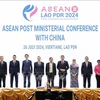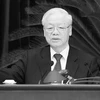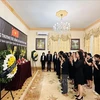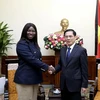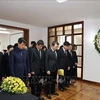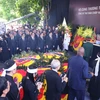Long time ago, the feudal state of Vietnam carried out policies to send people to Hoang Sa and Truong Sa archipelagoes to affirm its national sovereignty, said the People’s Army Newspaper online on May 22.
It was important to note that the state’s policies received the active support of citizens which had been reflected through cultural documents and folk verses being handed down from generation to generation of islanders. Cultural documents showing people’s noble sacrifices for the sacred national sovereignty over sea and islands touched scientists’ hearts and were seen as golden evidence determining that Hoang Sa and Truong Sa archipelagoes have been parts of Vietnam’s territory through long history.
This was affirmed by Prof. Dr. Nguyen Quang Ngoc, Director of National University’s Institute of Vietnamese Studies and Development Science, who has spent over 20 years studying antique maps and documents relating to Hoang Sa and Truong Sa, in a recent interview with the People’s Army Newspaper about scientifically historical evidence affirming Vietnam’s sovereignty over sea and islands.
Ngoc started studying old maps of national sovereignty in 1993 as he was assigned to be the head of a state level project on national sovereignty over Hoang Sa and Truong Sa. In spite of being busy teaching, he spent most of his time collecting international documents, especially maps, including Chinese ones relating to the two archipelagoes.
Prof. Ngoc remembered the time when he and his fellows came to original Cu Lao Re (present Ly Son island district) to find evidence. In spite of difficulties, islanders were very enthusiastic and created most favourable conditions to help Ngoc’s delegation fullfil its mission, offering Ngoc’s team many useful documents that they had. Ly Son Island made Ngoc believe that the spirit of defending national sovereignty over sea and islands of Vietnamese people has been built very long time ago.
Ngoc also traveled to various countries to search for antique maps relating to Truong Sa and Hoang Sa archipelagoes with the assistance of his friends. “Learning that I have been studying documents and maps of the two archipelagoes, many friends of mine, mostly friends of these countries wholeheartedly support me in finding and researching as well”, said Ngoc.
During his 20 years of teaching, Ngoc has passed down the passion of studying documents about Truong Sa and Hoang Sa Archipelagoes, patriotism and responsibility of defending the sacred national sovereignty over sea and islands to various generations of students.
He added that it was thanks to one of his students, Nguyen Thi Hai, who was studying in Paris, France that he could find an invaluable international atlas, named “Atlas Universel de Geographie” (World Atlas of Geography), asserting Vietnam’s obvious ownership of Hoang Sa and Truong Sa.
The atlas, with six volumes, compiled by a Belgian geographer Philippe Vandermaelen and published in 1827 in Brussels, Belgium, is evaluated as an invaluable evidence affirming Vietnam’s sovereignty over Hoang Sa and Truong Sa archipelagoes. It was announced by the Ministry of Information and Communications last mid May.
The atlas includes four maps of Vietnam under the name “De che An Nam” (An Nam Empire) by Western people with a brief introduction of “An Nam Empire” sticking next to the Hoang Sa archipelago. This affirms that Hoang Sa is part of “Dang trong” (Cochinchine) of Vietnam. The names of islands in Hoang Sa Archipelago have not changed until today.
Hai discovered the map numbered 106, called Partie de la Cochinchine, part of the Atlas when she studied in the French National Library. Knowing that Ngoc has passion for studying documents about Hoang Sa and Truong Sa, she photographed the map and sent it to Ngoc.
Realising that this was an invaluable map clearly affirming Vietnam’s sovereignty, Ngoc asked her to buy the copied map which is evaluated as a valuable evidence proving that Hoang Sa and Truong Sa belong to Vietnam. Then, he decided to trace the origin and conduct intensive study on the international map which is very important to Vietnam. After Hai had assured that the map was exactly published in Belgium in 1827, Ngoc asked the Ministry of Information and Communications to create favourable conditions for him to directly find the original map.
His proposal was approved and Ngo Chi Dung, Eco Pharma Co.’s Director, who bought all six original volumes of the atlas in Belgium’s Gent city, including Partie de la Cochinchine and brought home to add more scientifically historical evidences to assert Vietnam’s sovereignty over sea and islands, sponsoring Ngoc’s researches on the atlas in foreign countries.
Philippe Vandermaelen’s atlas is reliable as it was created based on the world’s best maps in early 19th century. Through field surveys and researches, experts verified that the atlas accurately drawn in detail by scientific methods is the original.
The professor affirmed that in spite of studying many old international maps relating to Hoang Sa and Truong Sa, this atlas was one of the invaluable maps affirming Vietnam’s indisputable sovereignty over the two archipelagoes.
“The atlas is invaluable by its objectiveness and scientific grounds asserting Vietnam’s sovereignty over sea and islands.”-VNA
It was important to note that the state’s policies received the active support of citizens which had been reflected through cultural documents and folk verses being handed down from generation to generation of islanders. Cultural documents showing people’s noble sacrifices for the sacred national sovereignty over sea and islands touched scientists’ hearts and were seen as golden evidence determining that Hoang Sa and Truong Sa archipelagoes have been parts of Vietnam’s territory through long history.
This was affirmed by Prof. Dr. Nguyen Quang Ngoc, Director of National University’s Institute of Vietnamese Studies and Development Science, who has spent over 20 years studying antique maps and documents relating to Hoang Sa and Truong Sa, in a recent interview with the People’s Army Newspaper about scientifically historical evidence affirming Vietnam’s sovereignty over sea and islands.
Ngoc started studying old maps of national sovereignty in 1993 as he was assigned to be the head of a state level project on national sovereignty over Hoang Sa and Truong Sa. In spite of being busy teaching, he spent most of his time collecting international documents, especially maps, including Chinese ones relating to the two archipelagoes.
Prof. Ngoc remembered the time when he and his fellows came to original Cu Lao Re (present Ly Son island district) to find evidence. In spite of difficulties, islanders were very enthusiastic and created most favourable conditions to help Ngoc’s delegation fullfil its mission, offering Ngoc’s team many useful documents that they had. Ly Son Island made Ngoc believe that the spirit of defending national sovereignty over sea and islands of Vietnamese people has been built very long time ago.
Ngoc also traveled to various countries to search for antique maps relating to Truong Sa and Hoang Sa archipelagoes with the assistance of his friends. “Learning that I have been studying documents and maps of the two archipelagoes, many friends of mine, mostly friends of these countries wholeheartedly support me in finding and researching as well”, said Ngoc.
During his 20 years of teaching, Ngoc has passed down the passion of studying documents about Truong Sa and Hoang Sa Archipelagoes, patriotism and responsibility of defending the sacred national sovereignty over sea and islands to various generations of students.
He added that it was thanks to one of his students, Nguyen Thi Hai, who was studying in Paris, France that he could find an invaluable international atlas, named “Atlas Universel de Geographie” (World Atlas of Geography), asserting Vietnam’s obvious ownership of Hoang Sa and Truong Sa.
The atlas, with six volumes, compiled by a Belgian geographer Philippe Vandermaelen and published in 1827 in Brussels, Belgium, is evaluated as an invaluable evidence affirming Vietnam’s sovereignty over Hoang Sa and Truong Sa archipelagoes. It was announced by the Ministry of Information and Communications last mid May.
The atlas includes four maps of Vietnam under the name “De che An Nam” (An Nam Empire) by Western people with a brief introduction of “An Nam Empire” sticking next to the Hoang Sa archipelago. This affirms that Hoang Sa is part of “Dang trong” (Cochinchine) of Vietnam. The names of islands in Hoang Sa Archipelago have not changed until today.
Hai discovered the map numbered 106, called Partie de la Cochinchine, part of the Atlas when she studied in the French National Library. Knowing that Ngoc has passion for studying documents about Hoang Sa and Truong Sa, she photographed the map and sent it to Ngoc.
Realising that this was an invaluable map clearly affirming Vietnam’s sovereignty, Ngoc asked her to buy the copied map which is evaluated as a valuable evidence proving that Hoang Sa and Truong Sa belong to Vietnam. Then, he decided to trace the origin and conduct intensive study on the international map which is very important to Vietnam. After Hai had assured that the map was exactly published in Belgium in 1827, Ngoc asked the Ministry of Information and Communications to create favourable conditions for him to directly find the original map.
His proposal was approved and Ngo Chi Dung, Eco Pharma Co.’s Director, who bought all six original volumes of the atlas in Belgium’s Gent city, including Partie de la Cochinchine and brought home to add more scientifically historical evidences to assert Vietnam’s sovereignty over sea and islands, sponsoring Ngoc’s researches on the atlas in foreign countries.
Philippe Vandermaelen’s atlas is reliable as it was created based on the world’s best maps in early 19th century. Through field surveys and researches, experts verified that the atlas accurately drawn in detail by scientific methods is the original.
The professor affirmed that in spite of studying many old international maps relating to Hoang Sa and Truong Sa, this atlas was one of the invaluable maps affirming Vietnam’s indisputable sovereignty over the two archipelagoes.
“The atlas is invaluable by its objectiveness and scientific grounds asserting Vietnam’s sovereignty over sea and islands.”-VNA
